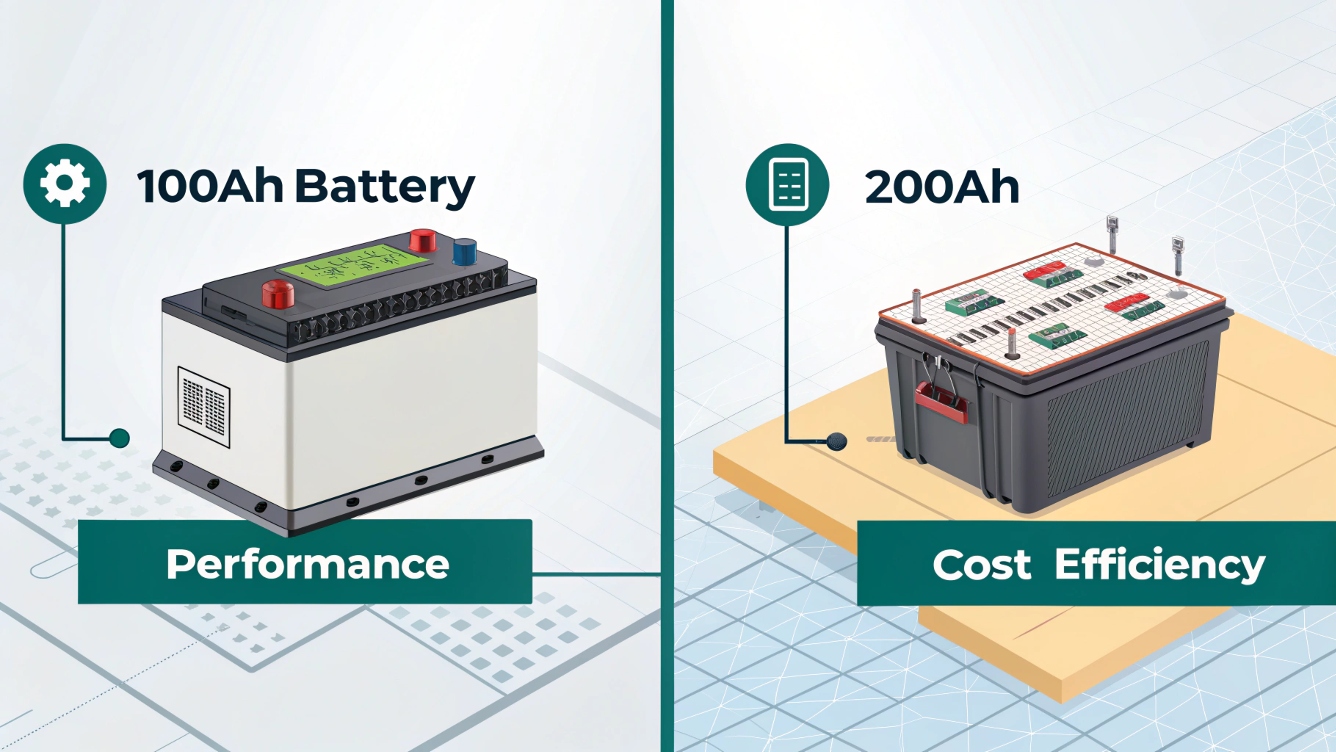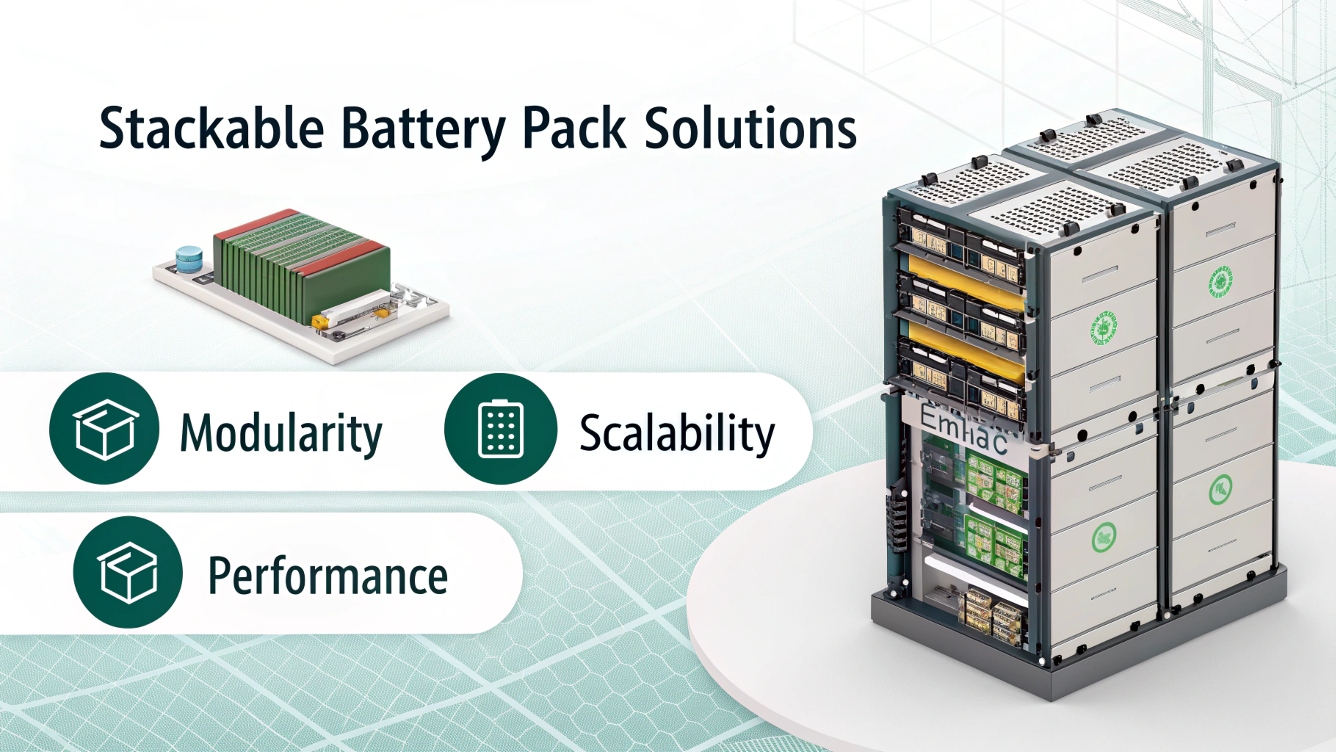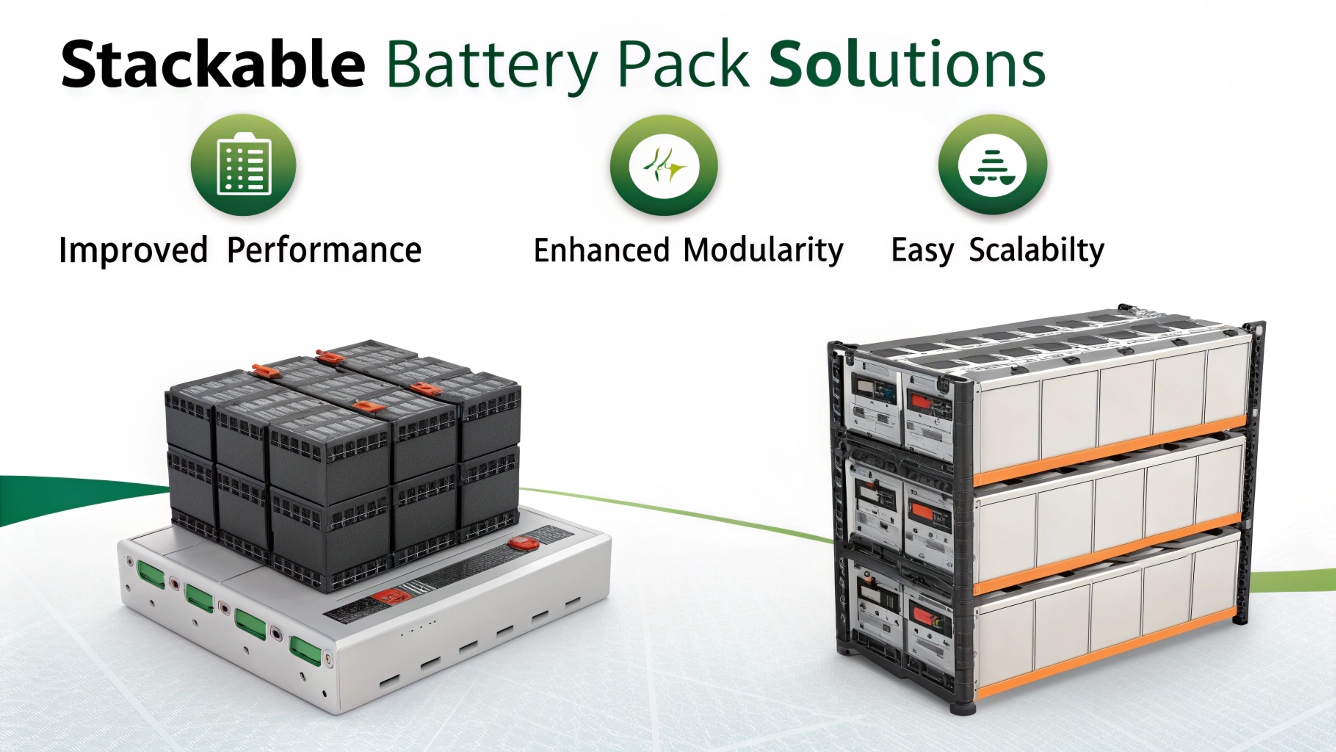هل من الأفضل أن يكون 2 100آه بطاريات الليثيوم أو 1 200آه بطارية ليثيوم? رؤى حول حلول حزمة البطارية القابلة للتكديس
يعد اختيار تكوين البطارية المناسب قرارًا حاسمًا لأي شخص يقوم بتصميم نظام تخزين الطاقة. يجب أن تختار بطاريتين ليثيوم 100ah أو وحدة 200ah واحدة? في هذه المقالة, نستكشف هذا السؤال أثناء فحص فوائد الحديثة أيضًا حزمة بطارية قابلة للتكديس الحلول. من خلال فهم التقنية, اقتصادي, والجوانب العملية لهذه التكوينات, يمكنك اتخاذ قرار أكثر استنارة يتوافق مع احتياجات الطاقة الخاصة بك وأهداف الاستدامة طويلة الأجل.
يتم دعم البيانات والمعلومات الفنية في هذه المقالة بمعايير الصناعة والأرقام الرئيسية الملخصة على ويكيبيديا بطارية ليثيوم أيون صفحة.
مقدمة

عندما تصبح أنظمة الطاقة المتجددة أكثر انتشارًا, تنمو الحاجة إلى تخزين البطارية الموثوق والقابل للتطوير. في GYCX الشمسية, تم تصميم منتجاتنا المتقدمة لتوفير الكفاءة, الشكل, وأداء قوي. سواء كنت تعمل على تشغيل المنشآت الشمسية خارج الشبكة أو دمج أنظمة الطاقة الاحتياطية, يعد فهم الفروق الدقيقة في تكوينات البطارية أمرًا ضروريًا.
عند مقارنة بطاريتين ليثيوم 100ah مع بطارية ليثيوم 200ah, هناك عدة عوامل تدخل في اللعب: أداء, قابلية التوسع, يكلف, سهولة الصيانة, والموثوقية طويلة الأجل. بخاصة, حديث حزمة بطارية قابلة للتكديس قدمت الحلول مستوى جديد من المرونة, السماح للمستخدمين بتوسيع نطاق أنظمتهم بشكل تدريجي مع ضمان الاستخدام الأمثل للطاقة المتاحة.
هذا الدليل يكسر المكونات الرئيسية لكل تكوين, يناقش فوائد الأنظمة القابلة للتكديس, ويستخدم أمثلة من مجموعة منتجاتنا لتوضيح كيفية تحقيق أفضل أداء لنظام تخزين الطاقة الخاص بك.
العوامل الرئيسية في تكوين البطارية
قبل الغوص في مناقشة 2 × 100AH مقابل. 1× 200AH بطاريات, من المهم فهم العوامل الأساسية التي تؤثر على أداء البطارية وكفاءة التكلفة.
القدرة وكثافة الطاقة
محددة السعة:
تقدم كلا التكوين نفس السعة الإجمالية (200آه), ولكن هناك اختلافات في كيفية توزيع الطاقة عبر الخلايا. غالبًا ما تأتي بطارية 200ah مع خلايا أكبر, والتي قد تؤثر على المقاومة الداخلية وكثافة الطاقة الكلية.كثافة الطاقة والأداء:
يمكن أن يكون للخلايا الكبيرة في بعض الأحيان كثافة طاقة أعلى, لكنهم قد يكونون أكثر صعوبة في إدارة الحراري. خلايا أصغر, على الجانب الآخر, عادةً ما توفر الإدارة الحرارية المحسنة ويمكن أن تكون أكثر كفاءة عند دمجها في حزمة بطارية قابلة للتكديس يسمح بالتوسع المعياري.
التكرار والموثوقية
- التكرار مع وحدات متعددة:
باستخدام بطاريتين 100AH يوفر التكرار المدمج. إذا واجهت إحدى البطارية مشكلات, لا يزال بإمكان الآخر تقديم الدعم الجزئي, الذي يضيف طبقة من السلامة. - عيوب وحدة واحدة:
تمثل بطارية 200ah واحدة نقطة فشل واحدة. إذا كانت هذه البطارية تعاني من خطأ, قد يتعرض نظام تخزين الطاقة بالكامل للخطر.
الصيانة والترقية
- قابلية الخدمة:
مع بطاريتين منفصلتين, يمكن أن تكون الصيانة أكثر مرونة. يمكنك استبدال أو خدمة بطارية واحدة دون إيقاف النظام بأكمله. - الشكل من خلال التراص:
حديث حزمة بطارية قابلة للتكديس تتيح لك الأنظمة أن تبدأ بسعة أصغر وإضافة المزيد من الوحدات النمطية حسب الحاجة. هذا النهج المعياري مثالي لتوسيع سعة النظام مع مرور الوقت, التأكد من أنك لا تدفع مبالغ زائدة من أجل السعة غير المستخدمة.
اعتبارات التكلفة
التكلفة الأولية مقابل. تكلفة دورة الحياة:
قد يختلف الاستثمار المقدم بين التكوينين. قد تكون بطاريتان أصغر أكثر تكلفة في البداية بسبب الحاجة إلى أنظمة إدارة إضافية وأجهزة التوصيل البيني, ومع ذلك ، يمكن أن تكون أكثر اقتصادا على المدى الطويل بسبب سهولة استبدال ودرجة انخفاض خطر تعطل النظام الكامل.وفورات الحجم في الأنظمة القابلة للتكديس:
أ حزمة بطارية قابلة للتكديس يمكن أن يوفر مزايا التكلفة من خلال السماح لك بالبدء في الاستثمار الصغير والاستثمار في سعة إضافية مع نمو متطلبات الطاقة الخاصة بك. هذه قابلية التوسع تضمن أنك تدفع فقط مقابل ما تحتاجه في كل مرحلة.
المقارنة الفنية: 2× 100AH مقابل. 1× 200AH
دعنا نقسم الجوانب الفنية بمزيد من التفصيل لمقارنة التكوينين.
الأداء الكهربائي والمقاومة الداخلية
سلسلة وتكوينات متوازية:
عند توصيل البطاريات, يمكن أن تتغير الخصائص الكهربائية بشكل كبير. ستشارك بطاريتان بالتوازي الحمل, التي يمكن أن تقلل من المقاومة الداخلية الفعالة وتؤدي إلى توصيل أكثر سلاسة للطاقة. هذا مفيد بشكل خاص في الأنظمة التي قد تكون فيها القمم الحالية عالية.الإدارة الحرارية:
تميل البطاريات الأصغر إلى تشتت الحرارة بشكل أكثر فعالية من بطارية واحدة أكبر. يعد تبديد الحرارة الفعال أمرًا بالغ الأهمية في منع التدهور وضمان صحة البطارية على المدى الطويل.التأثير على الكفاءة:
تؤدي المقاومة الداخلية المنخفضة إلى فقدان طاقة أقل كحرارة أثناء الشحن والتفريغ. يمكن تعزيز كسب الكفاءة هذا في أ حزمة بطارية قابلة للتكديس التصميم حيث يتم تحسين كل وحدة من أجل الحد الأدنى من الخسارة.
أوضاع السلامة والفشل
حماية البطارية الفردية:
في التكوينات متعددة الوحدات, عادة ما تأتي كل بطارية مع نظام إدارة البطارية الخاص بها (خدمات إدارة المباني), التي تراقب المعلمات الحرجة مثل الجهد, حاضِر, ودرجة الحرارة. هذا يعني أنه يمكن عزل خطأ في بطارية واحدة, تقليل خطر فشل النظام الكلي.BMS متكاملة في البطاريات الكبيرة:
قد تحتوي وحدة 200AH واحدة على BMS أكثر تعقيدًا. في حين أن أنظمة BMS الحديثة موثوقة للغاية, يزيد التعقيد من خطر الفشل على مستوى النظام إذا تعطلت BMS.
سيناريوهات استخدام العالم الحقيقي
أنظمة الطاقة الشمسية السكنية:
غالبًا ما يقدر مالكي المنازل التكرار وسهولة الصيانة. تتيح لهم بطاريتان 100AH الحفاظ على جزء من نظامهم حتى أثناء الصيانة. علاوة على ذلك, دمج هذه في حزمة بطارية قابلة للتكديس يمكن أن يوفر النظام مرونة إضافية مع تغير أنماط استهلاك الطاقة مع مرور الوقت.التطبيقات التجارية والصناعية:
في التركيبات الأكبر, قابلية التوسع وكفاءة التكلفة أمران بالغ الأهمية. أ حزمة بطارية قابلة للتكديس يمكّن النظام المستخدمين التجاريين من البدء بسعة أساسية وإضافة المزيد من الوحدات النمطية مع نمو متطلبات الطاقة الخاصة بهم أو مع تصاريح الميزانية. كما تقلل هذه الطريقة من التوقف أثناء الترقيات أو البدائل.
فوائد حلول حزمة البطارية القابلة للتكديس

مفهوم أ حزمة بطارية قابلة للتكديس يجمع بين مزايا النموذج, قابلية التوسع, وتحسين الأداء. فيما يلي بعض الفوائد الرئيسية:
الشكل وقابلية التوسع
التوسع الإضافي:
بتصميم قابل للتكديس, يمكنك أن تبدأ بأصغر, نظام يمكن التحكم فيه وإضافة المزيد من السعة تدريجيا. هذا مفيد بشكل خاص في المواقف التي من المتوقع أن تنمو فيها احتياجات الطاقة مع مرور الوقت.سهولة إعادة التكوين:
يتيح لك النهج المعياري إعادة تكوين بنك البطارية لمطابقة متطلبات التحميل بشكل أفضل. على سبيل المثال, إذا زاد استهلاك الطاقة الخاص بك, يمكنك ببساطة إضافة وحدة أخرى دون الحاجة إلى استبدال النظام بأكمله.
الموثوقية المحسنة
التكرار المدمج:
توفر حزمة البطارية القابلة للتكديس بطبيعتها التكرار. إذا فشلت وحدة واحدة أو تتطلب صيانة, يمكن للوحدات المتبقية الاستمرار في توفير الطاقة, ضمان الحد الأدنى من الاضطراب.مراقبة BMS الموزعة:
تتضمن كل وحدة في نظام قابل للتكديس عادةً BMS الخاص بها, الذي يوفر المزيد من المراقبة والتحكم الحبيبي. يؤدي هذا إلى موثوقية بشكل عام بشكل عام وعمر بطارية أطول.
الاستثمار الفعال من حيث التكلفة
انخفاض الاستثمار الأولي:
بدلاً من الاستثمار في نظام بطارية كبير الحجم مقدمًا, يمكنك مطابقة احتياجاتك الحالية والتوسع عند الضرورة. تتوافق هذه الاستراتيجية الاستثمارية التي تم تنظيمها بشكل أفضل مع قيود الميزانية ومتطلبات الطاقة المتطورة.الترقيات المطفأة:
على مدى حياة نظام الطاقة الخاص بك, يمكنك نشر التكاليف الرأسمالية. علاوة على ذلك, تساهم كفاءة أعلى وخفض تكاليف الصيانة في عملية أكثر فعالية من حيث التكلفة على المدى الطويل.
سهولة الصيانة
بدائل مبسطة:
يجب عطل الوحدة النمطية, يمكنك استبداله بشكل مستقل عن بقية النظام, ضمان الحد الأدنى من وقت التوقف وتقليل تعقيد الصيانة الشاملة.خيارات الخدمة المرنة:
مع وحدات متعددة, يمكن أن تكون الصيانة الروتينية متداخلة, التأكد من أن نظام تخزين الطاقة الإجمالي لا يزال يعمل بشكل مستمر.

دمج حلول المنتجات من GYCX Solar
في GYCX الشمسية, نحن نقدم منتجات بطارية متقدمة تجسد فوائد التصميمات المعيارية والقابلة للتكديس. دعونا نلقي نظرة على بعض العروض الرئيسية التي تدعم تخزين وإدارة الطاقة الفعالة.
بطاريات الليثيوم القابلة للتكديس
ملكنا بطاريات الليثيوم القابلة للتكديس تم تصميمها لتناسبها بسلاسة في نظام معياري. أنها تتيح التوسع التدريجي وتقديم أداء قوي, جعلها مثالية لكل من الطلبات السكنية والتجارية.
48V Rack Mount Lithium Battery
بالنسبة للتركيبات التي تتطلب حلًا مضغوطًا وفعالًا, ملكنا 48V Rack Mount Lithium Battery يوفر سعة عالية في تصميم لتوفير الفضاء. كفاءتها المهندسة تكمل الطبيعة المعيارية لـ حزمة بطارية قابلة للتكديس, مما يجعلها خيارًا شائعًا في المنشآت عالية الكثافة.
تخزين البطارية القابلة للتكديس
شامل تخزين البطارية القابلة للتكديس يجمع بين التكنولوجيا المتقدمة والتصميم العملي لتقديم حل تخزين الطاقة القابل للتطوير والآمن. تم تصميم هذا المنتج لدمجه بسلاسة في أنظمة حيث التكرار, أمان, وسهولة الترقية أمر بالغ الأهمية.
عن طريق ربط هذه المنتجات بشكل استراتيجي داخل مقالاتنا, نقوم بإنشاء شبكة قوية لا تعزز فقط تنقل المستخدم ولكن أيضًا يقوي محركات البحث (SEO) لموقعنا, التأكد من أن العملاء يمكنهم الوصول بسهولة إلى معلومات المنتج التفصيلية واتخاذ قرارات شراء مستنيرة.
اعتبارات عملية وحالات الاستخدام

لتوضيح إيجابيات وسلبيات التكوين-ومزايا التصميم القابل للتكديس-تستشير سيناريوهات العالم الحقيقي التالي:
الأنظمة الشمسية السكنية خارج الشبكة
تخيل منزلًا متزايدًا للطلب على الطاقة بسبب إضافة السيارات الكهربائية وزيادة استخدام الأجهزة. بدءًا من بطاريتين 100AH في حزمة بطارية قابلة للتكديس:
- التكرار:
إذا كانت بطارية واحدة تتطلب صيانة, يمكن للآخر الاستمرار في تشغيل الأحمال الحرجة. - قابلية التوسع:
مع زيادة احتياجات الطاقة, يمكن إضافة وحدات إضافية بسلاسة إلى مكدس البطارية الموجود. - فعالية التكلفة:
لا يزال الاستثمار الأولي معتدلاً, مع المرونة لتوسيع السعة بناءً على الاحتياجات المستقبلية.
حلول الطاقة الاحتياطية التجارية
للشركات الصغيرة التي تعتمد على الطاقة الاحتياطية أثناء انقطاع التيار الكهربائي:
- مصداقية:
يضمن النظام المصمم بحزمة بطارية قابلة للتكديس أنه حتى لو فشلت وحدة نمطية واحدة, لا يزال النظام العام يعمل. - استخدام الفضاء الفعال:
مضغوط 48V Rack Mount Lithium Battery توفر الوحدات سعة عالية في مساحة محدودة, مثالي للإعدادات الحضرية أو المقيدة بالفضاء. - انخفاض وقت التوقف:
يمكن إجراء الصيانة على وحدات فردية دون إيقاف النظام بأكمله, ضمان التشغيل المستمر خلال الفترات الحرجة.
تخزين النطاق الصناعي
تستفيد أنظمة تخزين الطاقة واسعة النطاق في الإعدادات الصناعية بشكل كبير من وحدة التصميم القابل للتكديس:
- تصميم مرن:
يمكن للشركات أن تبدأ بنظام أساسي وإضافة وحدات مع نمو احتياجات تخزين الطاقة, دون استبدال بنك البطارية بأكمله. - كفاءة محسنة:
تضمن عناصر التحكم في BMS الموزعة عبر وحدات متعددة أن كل وحدة تعمل بكفاءة ذروة, تقليل إجمالي فقدان الطاقة وتكاليف التشغيل.
تحليل البيانات ومقاييس الأداء
يمكن أن تساعد بعض نقاط البيانات الرئيسية في توضيح تأثير كل تكوين بطارية:
| المعلمة | 2× 100ah التكوين | 1× 200AH التكوين |
|---|---|---|
| إجمالي السعة | 200آه (موزعة عبر وحدتين) | 200آه (وحدة واحدة أكبر) |
| التكرار | عالية - يمكن أن تغطي وحدة واحدة في حالة الفشل | أقل - نقطة فشل واحدة |
| الإدارة الحرارية | بشكل عام أفضل بسبب تصميم الخلايا الأصغر | يمكن أن يكون تحديًا إذا لم يتم إدارته بشكل كافٍ |
| سهولة الصيانة | يمكن بيع الوحدات النمطية بشكل فردي | يجب خدمة الوحدة بأكملها |
| قابلية التوسع في نظام قابل للتكديس | ممتاز - يتكامل بشكل جيد مع الإعدادات المعيارية | محدودة - قد تكون هناك حاجة للاستبدال للتوسع |
هذه المقاييس مؤلفة وتعتمد على تصميمات النظام المحددة والبيئات التشغيلية. لمزيد من التفاصيل الفنية, الرجوع إلى ويكيبيديا بطارية ليثيوم أيون صفحة.
خاتمة
عند اتخاذ قرار بين بطاريات ليثيوم 2 × 100AH وبطارية ليثيوم واحدة 200AH, يتوقف الاختيار على عوامل متعددة بما في ذلك التكرار, الأداء الحراري, سهولة الصيانة, وقابلية التوسع في المستقبل. حديث حزمة بطارية قابلة للتكديس توفر الحلول فوائد مقنعة من خلال الجمع بين نقاط القوة والمرونة مع قوية, إدارة الطاقة الفعالة.
في GYCX الشمسية, خطوط منتجاتنا - بما في ذلك بطاريات الليثيوم القابلة للتكديس, 48V Rack Mount Lithium Battery, و تخزين البطارية القابلة للتكديس- تم تصميمها لتلبية هذه الاحتياجات. أنها توفر الموثوقية المعززة, صيانة مبسطة, وقابلية التوسع اللازمة للتكيف مع متطلبات الطاقة المتزايدة, جعلها خيارًا ممتازًا لكل من الطلبات السكنية والتجارية.
عن طريق وزن إيجابيات وسلبيات كل تكوين بعناية, يمكنك تصميم نظام تخزين لا يلبي متطلباتك الحالية فحسب ، بل يتكيف أيضًا مع النمو المستقبلي. سواء اخترت عدة وحدات أصغر أو بطارية واحدة أكبر, يضمن دمج نهج التصميم القابل للتكديس أن يظل نظامك مرنًا, فعالة من حيث التكلفة.


